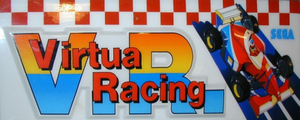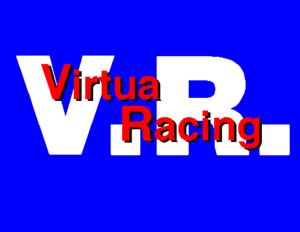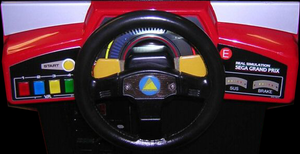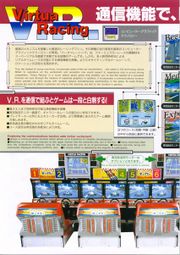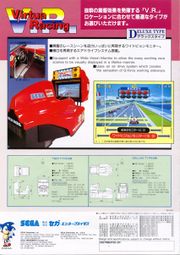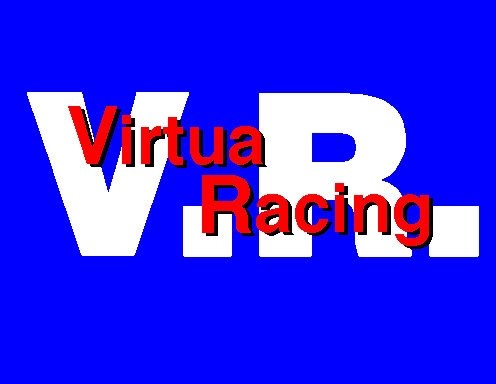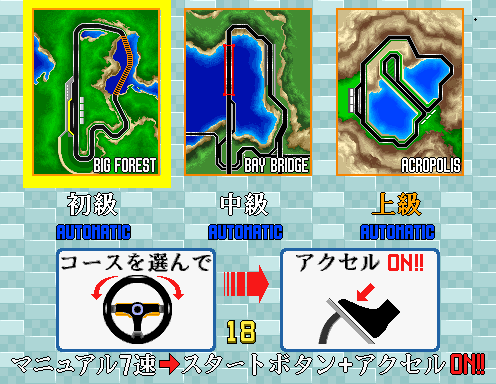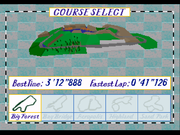Lost In Translation/V.R. - Virtua Racing
| V.R. Virtua Racing | |
|---|---|
| Manufacturer | Sega |
| Released | 1992 |
| Control Method |
Paddle Pedal 6 Button(s) |
| Main CPU | V60 (@ 16.000 MHz) 68000 (@ 10.000 MHz) |
| Sound CPU | Stereo YM3438 (@ 8.000 MHz) (2x) MultiPCM (@ 8.000 MHz) |
| Video Details |
Raster (Horizontal) 496 x 384 pixels 60.00 Hz 8,192 Palette colours |
| Screens | 1 |
| ROM Info | 28 ROMs 28,712,960 bytes (27.38 MiB) |
| MAME ID | vr · vformula |
About The Game
V.R. - Virtua Racing is a 3-D racing arcade video game.
Sega once again prove themselves to be kings of the racing genre with the superb and innovative "Virtua Racing". This was the first racing game to be fully rendered with shaded, filled polygon graphics (the first game to ever be rendered in filled polygons was Atari's incredible 1983 release, "I, Robot").
As well as the sublime graphics and superb playability, Virtua Racing also allowed players to switch camera views to suit their preferred style of play. The game features 3 well designed and varied courses; 'Big Forest', 'Bay Bridge' and 'Acropolis'.
Trivia
Sega went to General Electric Aerospace (who made the first 3-D simulators for NASA in the 1960s) in 1991-92 for assistance to develop a CG platform architecture for their new experimental 3-D system, which later became known as the Sega Model 1 hardware. Virtua Racer was the game being written to find out how viable hardware 3-D games were, it was never designed to be released, but it was such a success internally they decided to actually release it.
The first AM-2 polygon race game. The game features many epoch-making ideas : changing the point of view freely, feeling the hardness of the steering, the seat interacting with the gravity.
In true Sega fashion, their 'Virtua' prefix was used on a variety of other products such as "Virtua Fighter", "Virtua Cop", "Virtua Striker" and "Virtua Tennis".
Toshiba EMI released a limited-edition soundtrack album for this game (Virtua Racing & Out Runners - TYCY-5365, 5366) on 15/12/1993.
Staff
- Director & Chief Programmer
- Yu Suzuki
- Programmers
- Takuji Masuda
- Masahiko Kobayashi
- Masahiro Kawamura
- Kazuhiko Yamada
- Shin Kimura
- Chief Designer
- Toshihiro Nagoshi
- Designers
- Seiichi Ishii
- Kunihiko Nakata
- Toshiya Inoue
- Music Composer
- Takenobu Mitsuyoshi
- Sound Effect
- Yasuhiro Takagi
- Hardware Designers
- Shoji Nishikawa
- Keisuke Yasui
- Mechanical Effect Technician
- Masaki Matsuno
- Electrical Technician
- Futoshi Ito
- Program Supports
- Ikuo Taniguchi
- Yasuhito Shoji
- Satoshi Hosoda
- 'Fresh' Staffs
- Kohki Koiwa
- Takeshi Suzuki
- Toru Ikebuchi
- Yasuo Kawagoshi
- Yasuko Suzuki
- Nobukatsu Hiranoya
- Naomi Ota
Cabinet and Artwork
Ports
- Consoles
- Sega Mega Drive (1994)
- Sega 32x (1994, "Virtua Racing Deluxe")
- Sega Saturn (1995, "Time Warner Interactive's V.R. - Virtua Racing")
- Sony PlayStation 2 (2004, "Sega Ages 2500 Series Vol. 8 : V.R. - Virtua Racing Flat Out")
- Sony PlayStation 2 (2005, "Sega Classics Collection")
Soundtrack Releases
| Album Name | Catalogue No. | Released | Publisher | Comments |
|---|---|---|---|---|
| Virtua Racing & Out Runners | TYCY-5365~6[1] | 1993-12-15 | Toshiba EMI | 2 CD version. |
| Yu-Suzuki produce G-LOC / R360 / Virtua Racing | MJCAX-00013[2] | 1998-02-18 | Marvelous Entertainment, Inc. | CD version. |


